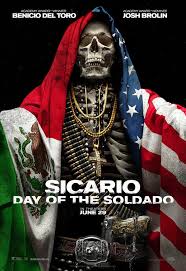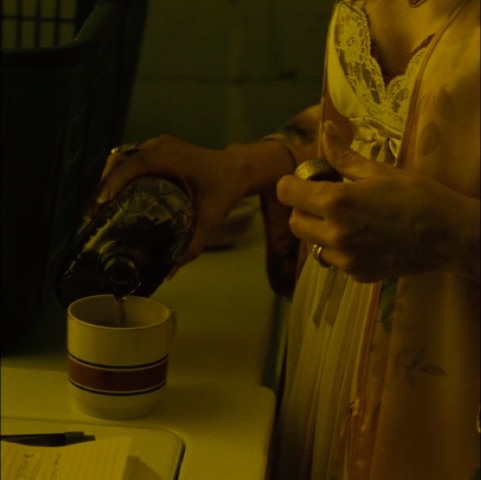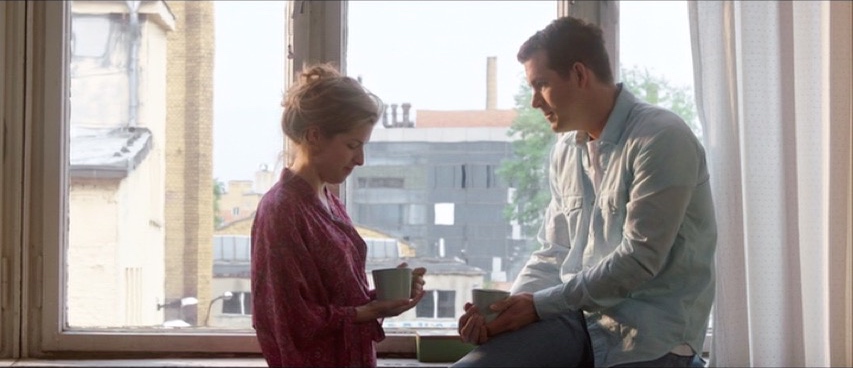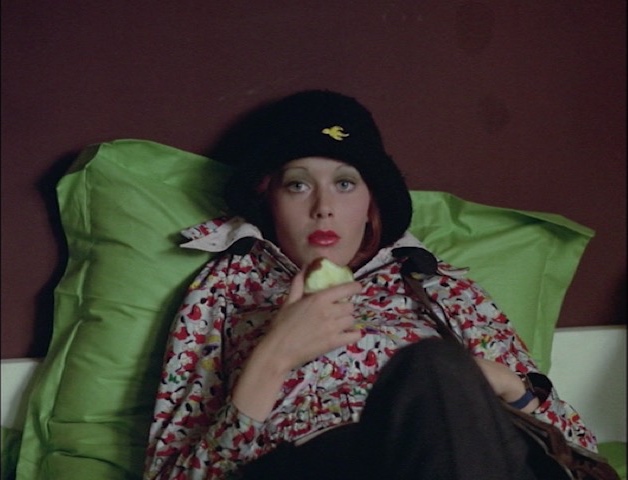« May 2018 | Main | July 2018 »
June 29, 2018
Sicario: Day of the Soldado

Stefano Sollima - 2018
Columbia Pictures 35mm
For those who've been following me here, seeing films theatrically, and writing about current theatrical releases, doesn't happen often. What makes this even more unusual is that the film in question is the follow-up to a film I liked but did not love. Why not call this a sequel? Although the narrative is presented in such a way that it is assumed the viewer is familiar with the characters played by Josh Brolin and Benicio del Toro, the narrative works as a standalone feature independent of any back story.
What initially intrigued me was well before the release today, reading that the director was Stefano Sollima. The last name was the same as that of the Italian director, Sergio Sollima, most famous for his trio of westerns featuring Tomas Milian as the rebellious peasant in films that served as political allegories. And sure enough, Stefano Sollima is the son. As it turns out, a fair amount of Stefano Sollima's work is easily available for stateside viewers and film critics who actually believe in the benefit of doing a little homework on the the filmmakers whose work is under consideration. The feature Suburra and the TV series Gomorrah are on Netflix, while the TV series Romanzo Criminale is on Amazon Prime.
I should note that Sollima only directed a handful of episodes of Gomorrah, but his visual style set the template for the rest of the series. Why I bring all of this up is because Sollima has been treated as incidental to the making of the film I will be referring to as Soldado or in some cases, has not been mentioned at all, with credit primarily going to screenwriter Taylor Sheridan. And while Sollima is admittedly a director for hire here in his English language debut, his previous work explains why he was given this gig, especially when Hollywood is notorious for giving foreign language filmmakers films that seemed doom to fail.
Suburra and the two series are about Italian crime families, inspired by true stories. Thematically, they are similar in that these are sometimes complicated narratives about rivalries between groups, as well as conflicting loyalties within the story's main group. There are scene of violence that erupt without warning. Visually, much of the action takes place in dimly lit places. Also, Sollima will film characters, as a group, from the back, seen as silhouettes.
Compared to Suburra, the narrative for Soldado is not very complicated. The only character that may keep the viewer guessing is that of Matt Graver, portrayed by Josh Brolin. There are a few moments where the film visually is similar to Sollima's previous work. Much as directors on a television series are hired to in part to maintain visual continuity between episodes, Sollima's job here was to provide a certain amount of consistency with the Denis Villaneuve's film visually with the sunbaked exteriors, and aurally with Hildur Guonadottir's music score which most closely resembles that of the late Johann Johannsson during the last major set piece. At this time, it appears that Sollima is set to do another Italian TV series, this time on drug trafficking. I would hope that Sollima makes another English language film, one more on his own terms.
Posted by Peter Nellhaus at 07:01 PM
June 24, 2018
Coffee Break

Anne Revere and Michael Redgrave in Secret Beyond the Door (Fritz Lang - 1948)
Posted by Peter Nellhaus at 10:32 AM
June 19, 2018
Back to Burgundy

Ce qui nous lie
Cedric Klapisch - 2017
Music Box Films Region 1 DVD
The original French title of Cedric Klapisch's new film translates as "What binds us". His working title, the homophonic Le vin et le vent translates as "The wine and the wind". Both titles are both more evocative of the familial conflicts at the heart of the film beyond the return of the prodigal son, Jean, to the family vineyard in Burgundy.
As Klapisch confirms in one of the DVD supplements, the film is something of a return to the kind of films made about twenty years ago with When the Cat's Away and Un air de famille. Both films primarily took place within a specific space, a working class neighborhood and the family home. Klapisch also pared away gimmicks and stylistic flourishes, save for a couple of moments when past and present co-exist. As a film about two adult brothers and a sister, Klapisch knows how to economically film the trio in conversation and be visually interesting without resorting to cutting between close-ups and back and forth shots. What is most radical a break for Klapisch is having a film taking place in a country setting, and using a cast of younger, less familiar actors.
After ten years of travel, youngest brother Jean returns to the family domain upon news of his father's illness. Warmly greeted by sister Juliette, Jean has a more tense relationship with older brother, Jeremie. With the death of the father, Jean stays to help with the impending harvest of the grapes. Jean reveals that for the past five years, he's been married with a son, with his own domain in Australia. The siblings have to decide what to do with the family domain as the income from the wine they sell is barely enough to cover the inheritance tax, while they could enjoy a significant profit from simply selling the land. The original French title is more meaningful with the conflicts between the siblings, whether Jean will return to Australia, Jeremie's attempts to keep the peace with his father-in-law - a competing wine maker, and Juliette's hesitation about taking over the family business.
Klapisch chose to make the film about Burgundy, the wine, as it was the favorite of his father's. Also, wine making in the province of Burgundy is still done by individuals and families, and not industrialized. Effort was made to make every aspect shown in both the vineyards and in the processing as authentic as possible. Much of the credit would go to Jean-Marc Roulot, an actual vinter and actor, who shares screenwriting credit and plays the part of the vineyard's operations manager. While not somber, there are just a few lightly comic moments, another break from the big laughs of Klapisch's more recent work.
Klapisch discusses the unusual making of Back to Burgundy in this brief interview.
Posted by Peter Nellhaus at 10:20 AM
June 17, 2018
Coffee Break

Anne Dorval in Mommy (Xavier Dolan - 2014)
Posted by Peter Nellhaus at 10:28 AM
June 14, 2018
Greaser's Palace

Robert Downey - 1972
Scorpion Releasing BD Region A
I wouldn't be surprised if a smart programmer at at revival house like the Castro in San Francisco has already booked this program, but for those who like to create their own double features at home, I recommend pairing this new blu-ray of Greaser's Palace with Steven Shainberg's Fur. The older film stars Allan Arbus in the lead role, while Fur is a fantasy biography of Arbus' former wife, photographer Diane Arbus, in part inspired by "Beauty and the Beast". And the beast opposite Nicole Kidman's beauty was played by Robert Downey, Jr. The seven year old Downey, Jr. also makes an appearance in his father's film.
A bit of background here - Robert Downey was what was known as an underground filmmaker, based in New York City in the Sixties. Several of those films have been issued as part of a set by Criterion. One of the early films, Chafed Elbows was successful enough for Downey to make his only film that was a critical and commercial hit on a national scale, Putney Swope, in 1969. The time was right for a satire on Madison Avenue and Black power. Pound, produced for United Artists, with live people as dogs in a, yes, pound, came and went. Neophyte producer Cyma Rubin was still hoping lightning would strike twice, with Downey given a budget of nearly a million dollars to write and direct Greaser's Palace. Keep in mind that Putney Swope was made on a budget reported at $120,000.
As it turned out Greaser's Palace had a polarizing response of those who loved it or hated it. The new blu-ray comes with notes by Jonathan Demme who connected with the absurd sense of humor. I also saw the film at the time of initial release, but save for a few moments find the film more funny peculiar, kind of like the friend or acquaintance that tells a story with a few forced chuckles, capping his conclusion with a line like, "I guess who had to be there". Downey's film is a parody of westerns mixed with some religious symbolism which may have worked on paper, but is only effective intermittently on screen.
The title is a play on Caesar's Palace, with a small western town run by Seaweedhead Greaser. The town's populace is primarily grizzled old men. The only woman is daughter Cholera, who provides entertainment with singing followed by briefly exposing her crotch to the appreciative audience. Jessy, parachuting into town wearing an anachronistic zoot suit and large pink fedora, may or may not be the messiah.
Among the better moments are when Jessy, played by Allan Arbus, comes to the shack of Herve Villechaize, a gay Mexican bandit wearing an oversized sombrero. There is something unexpectedly touching seeing Villechaize inch up next to Arbus with romantic longing. In a later scene, a pioneer woman, barely surviving an Indian attack, crawls across the desert, pulls an arrow out of her bleeding leg, only to have another arrow shot into the exact same spot.
The blu-ray comes with a short interview conducted by writer Rudy Wurlitzer with Downey, discussing the history of the film. One of interesting anecdotes is that some of the casting was done near the office of Jack Nicholson, resulting in the casting of Luana Anders as Cholera and a topless Toni Basil as an Indian girl. Another notable credit is that of Jack Nitzsche for the song lyrics and music, one of his first film scores, with songs that almost sound authentic for the era.
Posted by Peter Nellhaus at 10:10 AM
June 12, 2018
The Woman in the Window

Fritz Lang - 1944
KL Studio Classics BD Region A
First off, I'm going to assume that anyone who reads this is already familiar with the movie, or the story and plot twist at the end. I also have to say that I don't think I have to much to say that hasn't been said before or better by others. As far as commentary tracks go, there is a certain amount of trepidation on my part, with some almost disastrously improvised by people who are audibly scrambling for their notes or stating "facts" that can be disproven with a little research. Imogen Sara Smith knows her stuff, and her commentary track is definitely worth a listen, even if you've seen Woman in the Window multiple times as I have prior to the new blu-ray release.
Now about that twist ending . . . Edward G. Robinson is seen in the earlier scene, taking an illustrated copy of "Song of Songs" from the library of the gentlemen's club, sitting down with the drink he had ordered, advising the waiter to notify him when it is 10:30 pm. When 10:30 rolls around, Robinson leaves the club for that fateful meeting on the street with Joan Bennett. The surprise for viewers is the reveal that the meeting and subsequent events were all part of a very detailed dream. And yet . . . maybe it's my own interpretation of what I'm looking at on the screen, but when Robinson is framed in that medium shot, with the book in hand and drink at the side, when it is still about 9:15 pm or so, Robinson's eyes seem to be closing. We're only talking about a few frames in a shot that dissolves to the shot of Robinson being reminded that it is 10:30 pm, but Robinson's face in that shot has the appearance of someone at least ready to fall asleep. And again, maybe it's how I'm reading that shot, but it would suggest that Lang was playing with the inattention of viewers, plus the subtlety of bringing something like this off when the film could only be seen theatrical, indicating that Robinson was in a dream state when the bulk of the film takes place.
While there may not be obvious dream logic, there are also a couple of moments that are questionable. When Robinson is attacked by the man known as Frank, is he consciously reaching out for the pair of scissors? And why does Bennett give Robinson the scissors instead of stabbing Frank herself, if not fatally at least enough to stop him from trying to kill Robinson? And the shootout near the end, with the police hot on the trail of Dan Duryea, with the cop shooting at Duryea from inside the police car makes no visual sense. I have to wonder how Duryea gets killed when it doesn't even appear that the cop and the blackmailer can even see each other?
Of course these are things you don't notice when the story whizzes by. Time is always of the essence, with shots of clocks in close-up or within the frame. One of the other benefits of watching a film on blu-ray is to take advantage of freezing a shot, to discover that Bennett has hidden her blackmail loot under a copy of Thirty Clocks Strike the Hour, a very real 1932 novel by Vita Sackville-West. (Other than a very brief description about an old woman with a room with thirty clocks, I could find no detailed description of Saville-West's novel.)
I'm here mostly because I like Joan Bennett in her film noir period, the four films she did with Fritz Lang, plus Jean Renoir's Woman on the Beach and Max Ophul's The Restless Moment. Sure, Lang and scriptwriter Nunnally Johnson signal their intentions with the opening shot of Professor Robinson giving a lecture underneath the name Sigmund Freud written in huge letters. But the subsequent scene of Robinson smoking at the gentlemen's club is a reminder of the adage that sometimes a cigar is just a cigar, and sometimes a movie is best appreciated for its surface pleasures.

Posted by Peter Nellhaus at 10:00 AM
June 10, 2018
Coffee Break

Anna Kendrick and Ryan Reynolds in The Voices (Marjane Satrapi - 2014)
Posted by Peter Nellhaus at 09:40 AM
June 05, 2018
The Films of William Castle

Edited by Murray Leeder - 2018
University of Edinburgh Press
My introduction to William Castle was initially second hand. As a gullible seven year old, I was told about The Tingler by two slightly older neighbor boys who convinced me that there really was such a creature that could take over my spine. It wasn't until my parents were out of town, that away from their protective gaze, I saw my first Castle film, The House on Haunted Hill. I think it took me five viewings before it dawned on me that the Frank Lloyd Wright exterior had no relation to the creepy Victorian mansion interior of the titular house.
While one of the contributors here tries to frame Castle's often illogical narratives within Queer Theory, I think there is a simpler explanation. In his book on giallo cinema, Mikel Koven discusses the lack of narrative logic based on the premise that for the original Italian audience, movie going was a social experience that took place in second or third run theaters, and attention to the screen was mainly for the set pieces, usually a scene of murder. I have to think that as Castle's horror films were made primarily for an audience of older children and teenagers watching his films in neighborhood theaters and drive-ins, he understood that narrative logic was less important, and that the films would be seen and remembered for the reanimated corpses, skeletons and other visceral moments.
It's unsurprising that the contributors of an academic study on the films of William Castle would put more thought regarding Castle's films than Castle would have, if at all, with recurring themes and social significance. The book makes the point of noting that Castle made more than the horror films he is best remembered for, with a chapter offering an overview of his westerns. What I did find a bit frustrating is that the first chapter is devoted to Castle's first important film, When Strangers Marry, also known as Betrayed (1944). It's the second title that most connects Castle's well regarded film noir with the horror films he began making fourteen years later, with adulterous couples, and marriages and murder for financial gain in several of those films. One could make the case that Rosemary's Baby, originally bought by Castle to be his entry into A films, thematically fits with Castle's often brittle view marriage. Castle's horror films aren't just linked by the gimmicks, but by their plots centered on betrayal, spousal or otherwise.
Where the book is truly valuable is in placing Castle as a descendent of silent showmen in cinema's earliest years, before narrative filmmaking took over. There is also a review of how Castle understood how to use mass media to sell his films, with part of a chapter discussing the pioneering work of publicity agent Terry Turner. Castle's history as a filmmaker is also part of the film history that includes "spook shows", saturation booking, and a variety of publicity stunts. While there is also discussion on Castle versus Alfred Hitchcock, what is overlooked is how they both responded to Henri-Georges Clouzot's Les Diabolique (1955) in the same year, 1958, with markedly different results. Hitchcock's response was to get the film rights to the next novel by the authors of Les Diaboliques. It took several decades for Vertigo to gain critical attention or to be a profitable film. Castle mortgaged his house and made Macabre for $90,000.00, reworking Boileau and Narcejac's plot of an unfaithful spouse and a plan to scare someone to death, with a couple of moments of horror, all set in anonymous small town USA. Hitchcock essentially took Castle's playbook after getting his commitment to MGM out of the way.
Among the essays I liked best was Alexandra Heller-Nicholas on Mr. Sardonicus and the mask as a transformative device. One of my favorite Castle films is also one of his more serious films, with the option to "vote" on the fate of Sardonicus reportedly forced on Castle by Columbia Pictures who insisted on a gimmick when none was planned. Castle's film is rightly linked with The Man who Laughs (1928), which Castle probably saw as a teenager, with Guy Rolfe's grotesque "smile" more extreme than that of Conrad Veidt in the silent film. Michael Pettiti makes the case for The Night Walker (1964), a financial failure, critically dismissed like most of Castle's films. The onscreen reunion of the formerly married Barbara Stanwyck and Robert Taylor wasn't enough to interest adults away from the television sets, or a younger generation who had their proportionately younger stars. I haven't seen The Night Walker, but some of the elements suggest that there is a connection to be made between Stanwyck and Taylor and the more contemporary Mia Farrow and John Cassavetes in Rosemary's Baby.
That said, only the stuffiest and saddest of cinephiles would need this book to justify watching something as delirious and endearingly nutty as The Tingler or Homicidal!.

Posted by Peter Nellhaus at 10:00 AM
June 03, 2018
Coffee Break

Chloe Grace Moretz in The Equalizer (Antoine Fuqua - 2014)
Posted by Peter Nellhaus at 09:27 AM
June 01, 2018
Frank & Eva

Frank en Eva
Pim de la Parra - 1973
Cult Epics BD Regions ABC / Region 0 DVD two-disc set
The full English language title of Pim de la Parra's film is Frank & Eva: Living Together Apart. This married Dutch couple share the same house, but have separate bedrooms and very individual lives. Eva has her tailor shop, while Frank is said to be a top car salesman. Most of the movie is about Frank, who gets drunk, hates his job enough to not return after crashing a company owned car, has sex with any available female, and is in general an irresponsible lout. The sex as depicted here is relatively mild, so it may come to a surprise for some viewers that Frank & Eva was the film that ended previous Dutch censorship laws. The film can also be seen as an example of the kind of soft core erotic cinema that was commercially popular in the early 1970s.
The Dutch Eye Film Institute restored de la Parra's film, his most popular work at the time of release. With Cult Epic's home video version, de la Parra can be said to be restored as he was an almost forgotten part of Dutch film history in spite of his hand in making Dutch cinema commercially viable. This new disc set helps put things in perspective with a commentary track by de la Parra in English explaining the circumstances of making and releasing the film. One of the supplements is a discussion of erotic Dutch cinema featuring actress Willike von Ammelrooy. Whatever one might think about this story of a love-hate relationship of one couple, the film's historic significance is well established.
The film marked the debut of Sylvia Kristel, who essentially demanded that de la Parra give her a part in his next movie. Kristel is only in the film for a few minutes, seen partially nude during the opening credits during a wild ride in a car driven by the drunk, and inattentive, Frank. Those few minutes were enough to launch a career, with international stardom a year away in Emmanuelle. The film's Eva, Willeke von Ammelrooy, has had a substantial career, including playing the title role in the Oscar winning Antonia's Line. Hugo Metsers, Frank, has also appeared in Paul Verhoeven's Spetters and The Black Book. Even though Frank & Eva is in Dutch, the screenplay was co-written by de la Parra with Charles Gormley, a filmmaker who later gained acclaim in his native Scotland. The often avant-garde score was by Antoine Duhamel, following work done for Godard and Truffaut.

Posted by Peter Nellhaus at 08:47 AM
